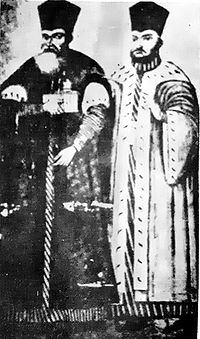
Constantin Cantemir
Encyclopedia

Moldavia
Moldavia is a geographic and historical region and former principality in Eastern Europe, corresponding to the territory between the Eastern Carpathians and the Dniester river...
n Voivode (Prince) between June 25, 1685 and March 27, 1693.
Life
Cantemir became a voivode at the age of 71, after being favored by the Ottoman EmpireOttoman Empire
The Ottoman EmpireIt was usually referred to as the "Ottoman Empire", the "Turkish Empire", the "Ottoman Caliphate" or more commonly "Turkey" by its contemporaries...
in his conflict with Dumitraşcu Cantacuzino. He participated in many campaigns of the Great Turkish War
Great Turkish War
The Great Turkish War refers to a series of conflicts between the Ottoman Empire and contemporary European powers, then joined into a Holy League, during the second half of the 17th century.-1667–1683:...
, assisting the Ottomans in their campaigns against the Polish-Lithuanian Commonwealth
Polish-Lithuanian Commonwealth
The Polish–Lithuanian Commonwealth was a dualistic state of Poland and Lithuania ruled by a common monarch. It was the largest and one of the most populous countries of 16th- and 17th‑century Europe with some and a multi-ethnic population of 11 million at its peak in the early 17th century...
and the Habsburg Monarchy
Habsburg Monarchy
The Habsburg Monarchy covered the territories ruled by the junior Austrian branch of the House of Habsburg , and then by the successor House of Habsburg-Lorraine , between 1526 and 1867/1918. The Imperial capital was Vienna, except from 1583 to 1611, when it was moved to Prague...
- nevertheless, he constantly informed the Polish and Habsburgs of the Turkish designs. During his rule, Moldavia was twice invaded, once by Nogai Tatars
Nogais
The Nogai people are a Turkic ethnic group in Southern Russia: northern Dagestan and Stavropol Krai, as well as in Karachay-Cherkessia and the Astrakhan Oblast; undefined number live in Chechnya...
, and a second time by Poland.
In 1691, Cantemir ordered Miron Costin
Miron Costin
Miron Costin was a Moldavian political figure and chronicler. His main work, Letopiseţul Ţărâi Moldovei [de la Aron Vodă încoace] was meant to extend Grigore Ureche's narrative, covering events from 1594 to 1660...
, a Moldavian chronicler and man of letters
Intellectual
An intellectual is a person who uses intelligence and critical or analytical reasoning in either a professional or a personal capacity.- Terminology and endeavours :"Intellectual" can denote four types of persons:...
, to be put to death on charges of conspiracy
Conspiracy (political)
In a political sense, conspiracy refers to a group of persons united in the goal of usurping or overthrowing an established political power. Typically, the final goal is to gain power through a revolutionary coup d'état or through assassination....
.
He was illiterate and, according to Ioan Neculce, could only write his own signature. Nonetheless, he ensured that his sons Antioh Cantemir
Antioh Cantemir
Antioh Cantemir , son of Constantin Cantemir and older brother of Dimitrie Cantemir , was a Moldavian Voivode between December 18, 1695 and September 12, 1700, and again from February 23, 1705 to July 31, 1707.-Reigns:He and Dimitrie successfully plotted against Prince Constantin...
and Dimitrie Cantemir
Dimitrie Cantemir
Dimitrie Cantemir was twice Prince of Moldavia . He was also a prolific man of letters – philosopher, historian, composer, musicologist, linguist, ethnographer, and geographer....
received a good education.

